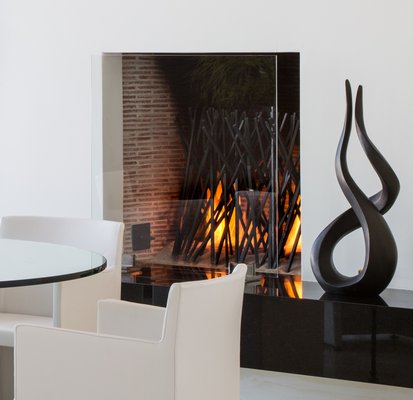
As we enter into the brisk days of fall—did anyone beside me think that autumn would never arrive?—our design focus might steer toward the fireplace in preparation for those bone-chilling days when flames from one’s firebox seem the only method to provide for a cozy, snuggling winter’s eve.
However, it is not the hearth furnishings, the fireplace facings, nor the mantel surrounds that I would like to address today—but simply the firebox itself. Much design attention has been lavished of late on this sooty hole, and I would be remiss not to call some attention to it.
If one has the luxury of building one’s own chimney, the firebox will most likely need to be lined with firebrick. Stanford White, who famously clad the interior of his fireboxes with expensive Delft tile, also employed a signature split brick herringbone running vertically up the back spine of the box. In fact, he not only split the typical brick in half, but at times, split the brick into four slices, turning them on their very thin end and running them up, herringbone style, the chimney box.
In many luxurious city dwellings where the fireboxes are quite shallow (attributed to the 18th century English Lord Rumford) with a rather square opening, one will discover elaborate iron or steel back plates lining two sides and the back of the firebox. These iron friezes were not simply for decoration, but they were specifically applied to help bounce the heat out into the room, reflecting greater warmth, before it escaped up the chimney. These iron firebacks also helped protect the firebrick and mortar from deterioration while providing a decorative opportunity to cheer up the charred blackened box. I recently bought one of my own.
In late Victorian times, when poorly drawing fireplaces spilled smoke from the upper portion of their openings, literal fabric valances were hung over the top of the firebox to push back the smoke escape. Though it actually worked, and I have seen them in person made of thick tapestry material, I would personally be fearful of a “curtained” conflagration!
Fast forward to contemporary fireboxes, where only gas and alcohol are burned. Designers and architects have invented countless, ingenious alternatives to the fake firewood syndrome. For instance, to break up the gas jets’ monotonous output, heaps of glass crystals or smooth glass pebbles allow the flames to magically appear from a transparent mound.
Odd as it may sound, a large, pyramidal stack of fire-resistant, concrete Bocce balls is a warm, modern alternative. Flicks lap the rounded surfaces with great panache. And perhaps you have seen clusters of iron sticks (looking like long crispy French fries) through which the gas flames may dance. In fact this theory of attenuated iron sculptures, with bird’s nest qualities, is hitting the fire hearth market in droves. They are rather mysterious and quite evocative.
Staring into that blackened square, so lifeless and unattractive, one can take heart that attractive choices exist to liven that sooty cavern and even provide a more sparkling entertainment. Fireplace retailers are providing more than just andirons and fire tools. Though I personally cannot imagine a fireplace without the sound and scents of the crackling wood burning, more environmentally sensitive alternatives are springing up everywhere and along with that, some very innovative approaches to lighting up your firebox.